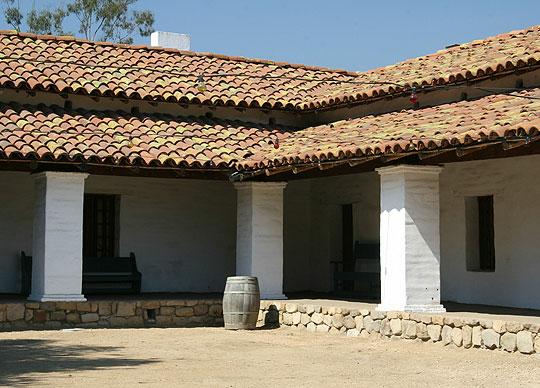Pueblo-Style Architecture in Santa Barbara Spanish influence was established early — but with a touch of green Casa de la Guerra was built in the 1820s to house Presidio Comandante José de la Guerra. (Marc Compton photo / Harrison Design Associates)

Thick plaster walls, burnt red roof tiles, and a relaxed Mediterranean climate are hallmarks of Santa Barbara’s architectural style. These hallmarks are living reminders of our city’s history. They reach back to the early days when the Spaniards first established their fort, or presidio, amid a thriving Chumash Indian civilization. For Spain, California was important in two ways.
The Spanish government wanted to establish presidios to defend its interests from Russian fur traders as well as those in the United States looking for a northwest passage. In addition, Spanish Franciscan friars, led by Father Junípero Serra, wanted to establish missions to spread Christianity to the natives. These dual purposes led the Spanish crown to work with Franciscans to establish 21 missions and four presidios along the California coast from 1769 to the early 1800s. The Presidio at Santa Barbara was the last of the four presidios to be established.
Founded in 1782, Santa Barbara’s presidio and surrounding adobes alluded to the beauty and care that Santa Barbara is famous for to this very day. As Capt. George Vancouver (after his visit in 1793) wrote, the presidio is “far more civilized than any of the other Spanish establishments ... The buildings appeared to be regular and well-constructed, the walls clean and white, and the roofs of the houses covered with a bright red tile. The presidio excels all the others in neatness, cleanliness, and other small though essential comforts.” (from James Early’s Presidio, Mission and Pueblo).
This care to detail, beauty, civility, and attention to the comforts of life has a long-standing tradition in Santa Barbara, dating back to the city’s founding. And, thanks to the efforts of the Santa Barbara Trust for Historic Preservation, the presidio is largely rebuilt, making it possible to experience the first landmark of our city’s history in all of its former glory. http://www.sbthp.org

Although Serra wanted to establish Mission Santa Barbara at the same time as the presidio, the mission was not founded until 1786 (two years after Serra’s death). As Early explains, the first mission was built of wood posts, or palisades, and covered in plaster. This was soon replaced by a larger adobe-brick mission that, by 1820, was replaced by a mission of sandstone block. Santa Barbara Mission. Positioned up on the hill overlooking the Santa Barbara Channel, the mission complex soon flourished with buildings, including a monastery, housing for the Indians, a water reservoir, aqueduct, granary and weavery. The Santa Barbara Mission was both a source of faith as well as a center of communal life for the newly founded community.
One exemplar of early adobe construction is Casa de la Guerra. Built in the 1820s by the presidio comandante, José de la Guerra, it is a perfect example of early Spanish Colonial architecture. Its massively thick walls tell of its adobe brick construction method while its simple round wood beams give it a powerfully rustic presence representing an era before industrialization or specialized tradesmen. The large clay barrel tiles remind one of its Spanish roots, as do the wood lintels that span the window and door openings. Even the tower at Casa de la Guerra — unusual for adobes of this time — tells of a connection to Spain. De la Guerra, a Spaniard by birth, had traveled to Mexico and then to Santa Barbara, where he was the comandante and a successful tradesman. As archeologist Michael Imwalle explains, by including a tower in the design, de la Guerra referenced his family crest, which has a tower as one of its symbols.
The family customs and traditions of Spain were being manifested in Santa Barbara. It was not only building methods and traditions that the Spaniards brought to California, however. They also brought their organization of public and private life. The plan is a powerful tool that organizes how people within the building interact with each other as well as how they interact with the public. Early adobes were often simple one- or two-room dwellings, which were then enlarged, if the family grew in wealth.
The house would continue to grow into an L, or even U, shape, around a central courtyard, with portales (covered walks) to shade the inhabitants from the sun. Individual rooms would often open directly onto the courtyard. As Gerald Foster notes, these L- and U-shaped houses were the early ancestors of the prolific American ranch house.
GREEN Architecture ... Old-World Style Since Santa Barbara has a Mediterranean-like climate, many of the same building principles apply to this region as in Spain. Thick white plaster walls with relatively few windows and doors block out much of the heat of the sun during the day and then release that same heat during the night.

In Spain, fireplaces were small since wood was scarce and upper-story windows were used for natural ventilation. Fired-clay tile roofs (which last to this day) minimized the long-term need to constantly replace roofing materials. These, and many other naturally developed techniques, continue to work as well in Santa Barbara as they do in Spain.
A modern Spanish Colonial Revival house utilizes traditional Spanish materials and forms that are naturally suited to the climate. Another important aspect, and one that is often overlooked, is the benefit that timeless beauty brings to the environmentally friendly table. If a building is both well made and in a beautiful architectural style (or “lovable,” as architect and New Urbanist Stephen Mouzon would say), it is more likely to be re-purposed/re-used, rather than demolished. And, considering the vast amount of energy that goes into making every building, it would be much easier on the environment if our buildings were made in beautiful styles and made to last.
Prior to our ability to overcome nature through technology, Spanish architecture learned to work with its environment in the most energy-efficient ways possible while adding details and embellishments for the sake of beauty. By doing so, traditional Spanish architecture was — and still is — a perfect fit for Santa Barbara.
The Past and the Future Adobe houses, the presidio, and the mission are all great examples that we have with us today of early Spanish Colonial architecture in Santa Barbara. By appreciating and understanding Santa Barbara’s roots, we can help continue the legacy of beauty that has been handed down for more than 200 years.
— Anthony Grumbine is a project designer at Harrison Design Associates, an architecture firm in Santa Barbara (as well as Beverly Hills and Atlanta) specializing in high-quality architecture in a range of styles. Harrison Design Associates is dedicated to the improvement of the field of architecture through study, education and leadership. Anthony can be reached at agrumbine@harrison-ca.com. Reprinted with Anthony's permission. http://www.harrisondesignassociates.com/
Kathleen Barnato Prudential CA Realty Santa Barbara/Montecito, CA 93108


Comments(0)